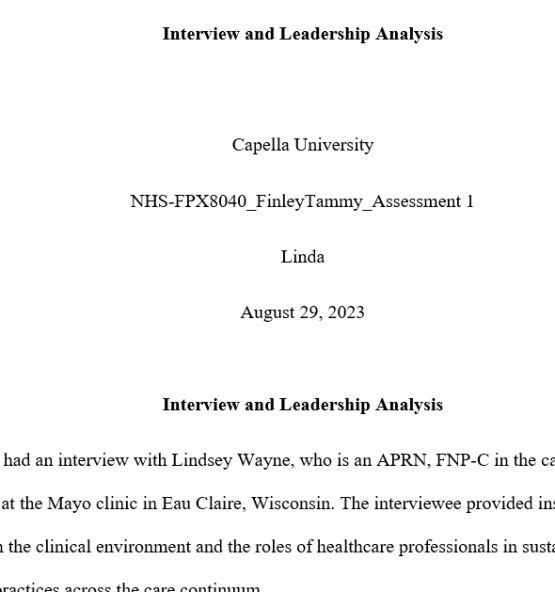


Interview and Leadership Analysis
Capella University
NHS-FPX8040_Assessment 1
Linda
August 29, 2023
Availability:In Stock
I had an interview with Lindsey Wayne, who is an APRN, FNP-C in the cardiology division at the Mayo clinic in Eau Claire, Wisconsin. The interviewee provided insights into the events in the clinical environment and the roles of healthcare professionals in sustaining safe and quality practices across the care continuum.
Leaders are key to transforming an organization in terms of the culture, processes, standards, and procedures. Lindsey uses transformational leadership in her practice. The approach entails motivating the workforce to understand their roles and perform beyond organizational expectations. In this case. Lindsey clarified the need for individual and collective commitment to demonstrating moral values and integrity that help optimize care and quality outcomes. The purpose of this paper is to understand what makes transformational leaders successful at the institutional level. According to Sfantou et al. (2017), transformational leadership means a leader engaging others in ways that raise everyone to high levels of motivation and morality. The style aligns with the demand for leaders who can help their organizations respond to rising demand for high-quality patient care.
One element of transformational leadership is inspirational motivation, which allows a leader to set a clear vision and communicate a sense of commitment and passion. Lindsey revealed the dedication to ensuring that everyone believes in themselves and do their best throughout the care process. The transformational leader also considers individual aspects by spending time engaging each team member (Bosak et al., 2020). The goal is to understand everyone’s strengths, weaknesses, and motivations. Equally, Lindsey seeks to provide mentorship to the workforce to make everyone responsive to trends in the modern care setting. Further, the leader emphasizes on intellectual stimulation by valuing ideas from team members and empowering everyone to think outside the box. In the end, the staff appreciate their roles in identifying new and better ways of accomplishing things in a complex healthcare environment. Lindsey’s transformational efforts are also visible through setting a good example for others to follow and become better employees.
Lindsey is a leader in her field she provides advanced education to her patients in order to help them manage their disease processes better. Many times providers are able to educate patients on their conditions and management during a routine visit, but Lindsey holds advanced education sessions in order to ensure that patients have a firm understanding of their disease process and ways to manage for the best outcomes and quality of life. Notably, one key to success for transforming a team and its culture is being transparent, communicating constantly with team members and embracing any tensions that may arise as a result (Bosak et al., 2020). As a change agent, Lindsey sets focus as on reaching out and helping others in Eau Claire County. She is using her tentacles to speak to the patients, families, communities, and other parties about chronic conditions such as cardiovascular disease processes, appropriate self-care management, and resources available to improve quality and safety of care while reducing costs. Lindsey also inspires and motivates new medical professionals by hosting monthly virtual training events for staff that has made a huge impact during the pandemic.
Qualifications to Be a Doctoral Preceptor
Lindsey Wayne is an APRN, FNP-C in the cardiology division at the Mayo clinic in Eau Claire, WI. She was a Registered Nurse for six years before, pursuing education as a Family Nurse Practitioner. She began her nursing education at the University of Wisconsin at Eau Claire where she obtained a Bachelor of Science in Nursing. She later attended Graceland University in Independence, Missouri where she obtained a Master of Science in Nursing with a concentration in Family Nurse Practitioner. Lindsey has certification from the American Academy of Nurse Practitioners as a Family Nurse Practitioner. Lindsey’s professional and educational experiences strengthen qualifications as a doctoral preceptor. Engaging Lindsey will provide insights into the various issues in the clinical environment and evidence-based interventions for sustaining the highest quality and safety standards.
A gap analysis helps illuminate areas that require significant improvements to enhance safety and quality outcomes. One area identified by Lindsey is worrying trends of patient falls and injuries. The challenges expose patients, organization, families, and healthcare professionals to adverse outcomes including additional costs, co-morbidity, and mortality threats. The acute care unit is the most affected, hence, the need for viable and sustainable interventions. One solution is implementing hourly rounding checklists. The approach makes the care team aware of gaps in the clinical environment such as poor bed positioning and inaccessible essentials that expose patients to falls and injuries (Anu, 2021). The comprehensive list and increased vigilance are appropriate for day and night shifts. Lindsey clarified the need for patient-centered and outcome-based practices guided by consistent scrutiny of events in the clinical environment. The objective is to reduce costs, shorten hospital stays, and reduce risk of readmissions.
Reviews
There are no reviews yet.